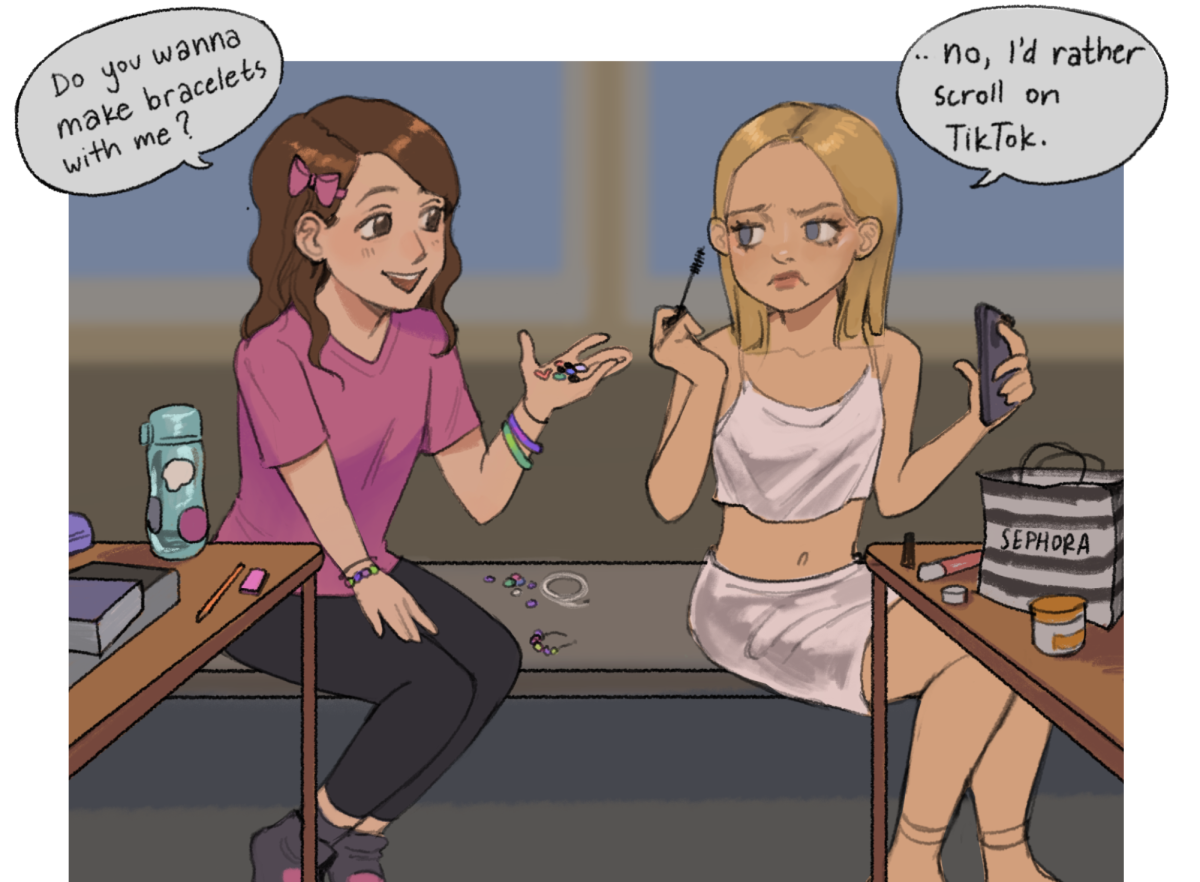Boy bands, Disney Channel and awkwardness defined tween culture in the 2000s and 2010s. Now it’s all about Sephora, Instagram and behaving like an adult.
A tween is anyone between the ages of nine and 13. This is a formative time for most young people, especially girls. The tween years are a time of self discovery and identity development. Tweens are often lumped in the same category as children, but that’s not entirely accurate.
Most tweens are already in middle school and find themselves in an awkward limbo; tweens are too old for most things marketed to kids, but still too young to participate in the same activities as teenagers. For some, this creates confusion over where to group tweens as both consumers and audiences. All the while, tweens continue to struggle with navigating their identity.
Wanting to be more like an adult is an interest shared by most young people. Kids look up to older figures in their lives and place them on pedestals. Celebrities, parents, older siblings and cousins can easily become idolized. Unfortunately, this admiration for adult figures, coupled with modern consumer culture, can lead to inappropriate and harmful imitation.
Trends like the Sephora kids epidemic, which began in early 2024, highlight just how extreme tween attempts to emulate adulthood can get. In a concerning fashion, preteens stormed Sephora, a cosmetics store specializing in makeup and skincare, desperate to purchase products from the likes of Drunk Elephant and Charlotte Tilbury.
Adult customers of numerous cosmetic brands found themselves contending with individuals who don’t even have their own money for the hottest makeup products.
These products are obviously not meant for the skin of preteens. Dermatologists have also voiced their concerns about young consumers of mature skincare products. Prominent ingredients, such as retinol and exfoliating acids and fragrances, can lead to skin irritation and development of contact allergies in youths.
Ironically, anti-aging products and routines are in particularly high demand amongst tweens. Anyone with an ounce of common sense can see how ridiculous this is, a perspective that is also widely shared by professionals.
But while growing trends continue to raise awareness surrounding this issue, the public responses that have ensued are cause for even greater concern. Adults, the very people tweens have gone so far off the deep end to mimic, have been shaming these kids and relentlessly mocking them on the internet. It’s as if these people forgot that they were also clueless kids once.
The tween phase has always been awkward. This is a time for fangirling and having bad taste in music. I remember my own tween years being filled with watching reruns of Hannah Montana and obsessively listening to One Direction. And while I might sometimes cringe at the thought of those years, being able to explore the things that appealed to me without having anyone tell me what I should care about has enabled me to grow in tune with my own identity.
Today’s tweens don’t have access to that same culture of unadulterated exploration.
They don’t even have Disney Channel anymore. Throughout the 2000s and 2010s, Disney Channel ruled tween culture. Stars like Miley Cyrus, Selena Gomez and Demi Lovato were the biggest role models to tweens watching them. Young girls, myself included, would try to emulate their style, look and talent. Tweens today look up to glamorous YouTubers and influencers with flawless skin as their role models.
Justice was my Lululemon and Claire’s was my Sephora. Where I had actors on TV to admire, kids today have Instagram and YouTube vloggers. Some may say it’s simply a harmless shift in influences. However, the content hasn’t simply shifted to something different, it’s become downright inappropriate.
The media’s current portrayal of beauty standards, for instance, is at an all-time low. Countless videos on YouTube and Instagram showcase unrealistic beauty routines and diets. Such widespread normalization of extreme lifestyles, the vast majority of which are enhanced through filters and lighting, is incredibly toxic.
When I was a tween I dreamed about wearing high heels and eye shadow. Nowadays, tweens dream about owning crop tops and getting botox.
Additionally, there is almost no modern media appropriately targeted towards preteens. Most current shows on Disney Channel, for example, are cartoons aimed at elementary schoolers. On the flip side, a lot of popular teen shows and movies that tweens turn to for entertainment instead are simply not appropriate for them.
The rise of streaming combined with a lack of shows and films aimed at tweens means they have started watching things that are too mature. We need to keep in mind that what is appropriate for a 16-year-old is not also appropriate for a 13-year-old.
What our society needs to do is re-examine and redress our approach to tween behavior. Making fun of cringy and childish behavior has become another toxic norm, so much so that kids today are doing everything they can to not act their age.
Middle schoolers are pressuring each other into wearing makeup and dressing in revealing clothes in order to appear cool. Stanley cups and makeup products have become determiners for their social status. Tweens are either scolded about behaving childishly, or judged for acting too old.
The best thing we can do to help kids experience their tween years fully is to just let kids be kids, with more encouragement and less ridicule.
This article originally appeared in the Spring 2024 print edition.



